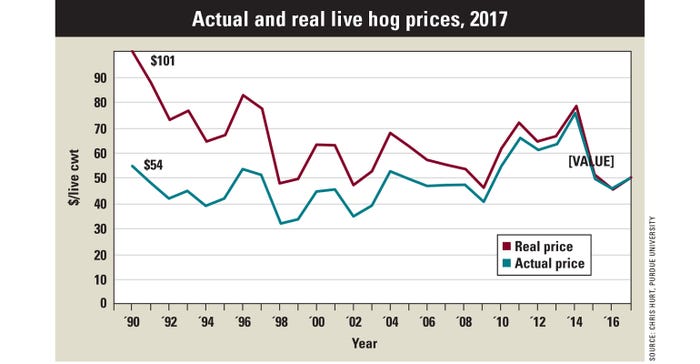November 6, 2017

By Chris Hurt
True or false: Prices for live hogs are lower today than they were in 1990. That’s true!
Hog prices are lower today than they were in 1990. Live hog prices will average about $51 per cwt in 2017, and they were $54 back in 1990. You can see the yearly price of hogs as the blue line in the graph below.
This just doesn’t make sense! With the costs of almost everything rising over the past 27 years, how could you be selling hogs at lower prices today? The government says the average costs of things consumers buy are 187% higher than 1990 prices, as measured by the Consumer Price Index. That means the average items purchased by consumers are almost twice as costly today.
What would that $54 live price in 1990 be in today’s terms if adjusted for inflation using the CPI? In 2017 dollars, the 1990 price of $54 would be equivalent to $101 per live cwt ($54 x 1.87). The red line in the graph shows yearly prices adjusted by the CPI for inflation. When an adjustment is made for inflation, this is called the “real” price. The real price of hogs has fallen from $101 in 1990 to $51 this year.

How has the pork industry been able to cut the real price of hogs nearly in half? One, feed costs have not gone up nearly as much as the general consumer inflation rate, and two, there have been huge productivity increases in hog production.
Facts behind numbers
Prices for feed ingredients are higher today than in 1990, but not nearly by as much as general inflation. U.S. farmer prices of corn averaged $2.40 per bushel in 1990, compared to around $3.30 in 2017. That is about a 37% increase in corn prices compared to a 187% increase in consumer prices.
Productivity gains in crop production have helped keep feed costs from going up much. However, the biggest contributor has been productivity gains in hog production.
The real price of hogs fell dramatically from 1990 to 2000. This was the period when the industry moved from relatively small family farms to our modern systems. The real price of hogs dropped from $100 to a range of $50 to $60.
Improved technology drove these lower real hog prices. Yet newer technology continues to find ways to increase output and drive costs per hundredweight lower. One clear lesson is that no industry stands still. Someone raising hogs with 1990 technology would be at a serious disadvantage today. The advantages of superior technology that drives costs lower favor the early adopters of that technology. In the long run, it favors pork consumers if real hog prices can be driven lower.
Ever-changing technology feels like a treadmill, but it’s necessary to get on that treadmill and improve human management capacity to continuously discover, evaluate and implement new technology.
Hurt is a Purdue University Extension ag economist. He writes from West Lafayette, Ind.
You May Also Like




